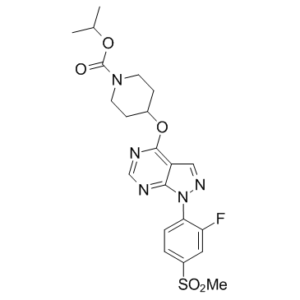APD 668
This product is for research use only, not for human use. We do not sell to patients.

For small sizes, please check our retail website as below: www.invivochem.com
| Size | Price | Stock |
|---|---|---|
| 250mg | $1450 | Check With Us |
| 500mg | $2100 | Check With Us |
| 1g | $3150 | Check With Us |
Cat #: V3354 CAS #: 832714-46-2 Purity ≥ 98%
Description: APD668 (also known as JNJ-28630368) is a novel and potent agonist of the pancreatic and GI-expressed orphan G-protein coupled receptor GPR119, with EC50 of 2.7 nM and 33 nM for hGPR119 and ratGPR119 respectively.
Top Publications Citing Invivochem Products
Publications Citing InvivoChem Products
Product Promise

- Physicochemical and Storage Information
- Protocol
- Related Biological Data
- Stock Solution Preparation
- Quality Control Documentation
| Molecular Weight (MW) | 477.51 |
|---|---|
| Molecular Formula | C21H24FN5O5S |
| CAS No. | 832714-46-2 |
| Storage | -20℃ for 3 years in powder formr |
| -80℃ for 2 years in solvent | |
| Solubility In Vitro | DMSO: 10 mMr |
| Water: N/Ar | |
| Ethanol: N/A | |
| SMILES Code | O=C(N1CCC(OC2=C3C(N(C4=CC=C(S(=O)(C)=O)C=C4F)N=C3)=NC=N2)CC1)OC(C)C |
| Synonyms | JNJ28630368; JNJ-28630368; JNJ 28630368; APD668; APD-668; APD 668 |
| Protocol | In Vitro | APD668 increases adenylate cyclase activation in HEK293 cells transfected with human GPR119 in a concentration-dependent manner with an EC50 of 23 nM |
|---|---|---|
| In Vivo | APD668 (0.08 mg/kg/min; i.v.) shows no effect during euglycemic condition, but significantly stimulates insulin release when blood glucose levels are raised to approximately 300 mg/dl in a hyperglycemic clamp model in the Sprague-Dawley rat | |
| Animal model | Male Zucker Diabetic Fatty (ZDF) rats (6 weeks old, 200-250 g) | |
| Dosages | 10, 30 mg/kg | |
| Administration | P.o. once daily for 8 weeks |
These protocols are for reference only. InvivoChem does not
independently validate these methods.
| Solvent volume to be added | Mass (the weight of a compound) | |||
|---|---|---|---|---|
| Mother liquor concentration | 1mg | 5mg | 10mg | 20mg |
| 1mM | 2.0942 mL | 10.4710 mL | 20.9420 mL | 41.8839 mL |
| 5mM | 0.4188 mL | 2.0942 mL | 4.1884 mL | 8.3768 mL |
| 10mM | 0.2094 mL | 1.0471 mL | 2.0942 mL | 4.1884 mL |
| 20mM | 0.1047 mL | 0.5235 mL | 1.0471 mL | 2.0942 mL |
The molarity calculator equation
Mass(g) = Concentration(mol/L) × Volume(L) × Molecular Weight(g/mol)
Mass
=
Concentration
×
Volume
×
Molecular Weight*
The dilution calculator equation
Concentration(start)
×
Volume(start)
=
Concentration(final)
×
Volume(final)
This equation is commonly abbreviated as: C1 V1 = C2 V2
Concentration(start)
C1
×
Volume(start)
V1
=
Concentration(final)
C2
×
Volume(final)
V2
Step One: Enter information below
Dosage mg/kg
Average weight of animals g
Dosing volume per animal µL
Number of animals
Step Two: Enter the in vivo formulation
%DMSO
+
%
+
%Tween 80
+
%ddH2O
Calculation Results:
Working concentration:
mg/ml;
Method for preparing DMSO master liquid:
mg
drug pre-dissolved in
µL
DMSO(Master liquid concentration
mg/mL)
,Please contact us first if the concentration exceeds the DMSO solubility of the batch of drug.
Method for preparing in vivo formulation:
Take
µL
DMSO master liquid, next add
µL
PEG300, mix and clarify, next add
µL
Tween 80,mix and clarify, next add
µL
ddH2O,mix and clarify.
Note:
- (1) Please be sure that the solution is clear before the addition of next solvent. Dissolution methods like vortex, ultrasound or warming and heat may be used to aid dissolving.
- (2) Be sure to add the solvent(s) in order.




































